B. J. Habibie
Bacharuddin Jusuf Habibie (Indonesian: [baxaˈrudːin ˈjusuf haˈbibi] (![]()
B. J. Habibie | |
|---|---|
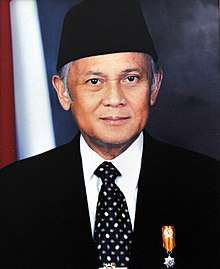 | |
| 3rd President of Indonesia | |
| In office 21 May 1998 – 20 October 1999 | |
| Vice President | none |
| Preceded by | Suharto |
| Succeeded by | Abdurrahman Wahid |
| 7th Vice President of Indonesia | |
| In office 11 March 1998 – 21 May 1998 | |
| President | Suharto |
| Preceded by | Try Sutrisno |
| Succeeded by | Megawati Sukarnoputri |
| 4th State Minister for Research and Technology of Indonesia | |
| In office 29 March 1978 – 16 March 1998 | |
| President | Suharto |
| Preceded by | Soemitro Djojohadikoesoemo |
| Succeeded by | Rahardi Ramelan |
| Personal details | |
| Born | Bacharuddin Jusuf Habibie 25 June 1936 Parepare Afdeling, Dutch East Indies |
| Died | 11 September 2019 (aged 83) Jakarta, Indonesia |
| Cause of death | Heart failure |
| Resting place | Kalibata Heroes Cemetery, Jakarta |
| Political party | Golkar |
| Spouse(s) | |
| Children | 2 |
| Mother | Tuti Marini Puspowardojo |
| Father | Alwi Abdul Jalil Habibie |
| Alma mater | ITB RWTH (Dipl.Ing.) RWTH (Dr.Ing.) |
| Occupation |
|
| Signature |  |
Early life

Habibie was a native of Parepare, in South Sulawesi. Habibie is an ethnic Gorontalese-Javanese descent from Kabila, Gorontalo and Yogyakarta.[1] His parents, Alwi Abdul Jalil Habibie,[1][2] an agriculturist of Gorontalese[3] descent, and R. A. Tuti Marini Puspowardojo,[4] a Javanese noblewoman from Yogyakarta,[5] met while studying in Bogor.[6] Habibie's family comes from Kabila, a village now sits in the eastern part of Gorontalo Province. He was the fourth of eight children.[7] Habibie's father died when he was 14 years old.[7]
Studies and career in Europe
Habibie went to Delft, the Netherlands, to study aviation and aerospace at the Technische Hogeschool Delft (Delft University of Technology), but for political reasons (the West New Guinea dispute between the Netherlands and Indonesia), he had to continue his study at the Technische Hochschule Aachen (RWTH Aachen University) in Aachen, Germany.[8] In 1960, Habibie received an engineer's degree in Germany with the title Diplom-Ingenieur. He remained in Germany as a research assistant under Hans Ebner at the Lehrstuhl und Institut für Leichtbau, RWTH Aachen to conduct research for his doctoral degree.[9]
In 1962, Habibie returned to Indonesia for three months on sick leave. During this time, he was reacquainted with Hasri Ainun, the daughter of R. Mohamad Besari. Habibie had known Hasri Ainun in childhood, junior high school and in senior high school at SMA Kristen Dago (Dago Christian Senior High School), Bandung. The two married on 12 May 1962, returning to Germany shortly afterwards.[10] Habibie and his wife settled in Aachen for a short period before moving to Oberforstbach. In May 1963 they had a son, Ilham Akbar Habibie.[11]
Habibie later found employment with the railway stock firm Waggonfabrik Talbot, where he became an advisor in designing train wagons.[12] Due to his work with Makosh, the head of train construction offered his position to Habibie upon retirement three years later, but Habibie refused the position.[13][12]
In 1965, Habibie delivered his dissertation in aerospace engineering and received the grade of "very good," giving him the title Doktoringenieur (Dr.-Ing.). The same year, he accepted Hans Ebner's offer to continue his research on Thermoelastisitas and work toward his Habilitation, but he declined the offer to join RWTH as a professor. His thesis about light construction for supersonic or hypersonic states also attracted offers of employment from companies such as Boeing and Airbus, which Habibie again declined.[14]
Habibie did accept a position with Messerschmitt-Bölkow-Blohm in Hamburg. There, he developed theories on thermodynamics, construction, and aerodynamics known as the Habibie Factor, Habibie Theorem, and Habibie Method, respectively. He worked for Messerschmitt on the development of the Airbus A-300B aircraft. In 1974, he was promoted to vice president of the company.[15]
Career in Indonesia
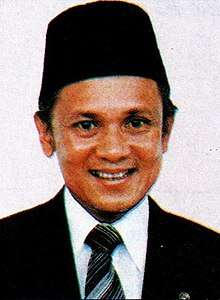
In 1974, Suharto recruited Habibie to return to Indonesia as part of his drive to industrialize and develop the country. Habibie initially served as a special assistant to Ibnu Sutowo, chief executive officer of the state oil company Pertamina and Chair of Agency for the Assessment and Application of Technology (Indonesian: Badan Pengkajian dan Penerapan Teknologi, BPPT). Two years later, Habibie was made CEO of the new state-owned enterprise Industri Pesawat Terbang Nurtanio (IPTN; Nurtanio Aircraft Industry),[15] which in 1985 changed its name to Industri Pesawat Terbang Nusantara (Nusantara Aircraft Industry; also abbreviated as IPTN) and is known as Indonesian Aerospace (PT. Dirgantara Indonesia) since 2000). In 1978, he was appointed as State Minister of Research and Technology (Indonesian: Menteri Negara Riset dan Teknologi, Menristek). He continued to play an important role in IPTN other "strategic" industries in this post.[15] By the 1980s, IPTN had grown considerably, specializing in the manufacture of helicopters and small passenger planes. Under Habibie's leadership, IPTN became a manufacturer of aircraft including Puma helicopters and CASA planes. It pioneered a small passenger airplane, the N-250 Gatotkaca, in 1995, but the project was a commercial failure.[16] In developing Indonesia's aviation industry, he adopted an approach called "Begin at the End and End at the Beginning".[17] In this method, elements such as basic research became the last things upon which to focus, whilst actual manufacturing of the planes was placed as the first objective.

By 1991, Habibie oversaw ten state-owned industries including ship- and train-building, steel, arms, communications, and energy.[15] A 1993 estimate determined that the estimates used nearly $2 billion a year in state funding, although the government's opaque accounting practices meant that the size of the industries was not completely known.[18]
As minister, Habibie created the OFP (Overseas Fellowship Program), STMDP (Science Technology and Manpower Development Program) and STAID (Science and Technology for Industrial Development). These three programs provided scholarships to thousands of high school graduates to earn their bachelor's degrees in the STEM fields and for other technical professionals to continue their study for master's and doctorate program in the United States, Europe, Japan, and other countries.[19]
Habibie was, continuously, a member of six Indonesian cabinets for over 20 years. After his initial appointment in 1978, he served in another five cabinets (including the Development Reform Cabinet which, as president he formed after the resignation of Suharto in May 1998):
- 1978–1983: State Minister of Research and Technology and Chair of Agency for the Assessment and Application of Technology in the Third Development Cabinet
- 1983–1988: State Minister of Research and Technology and Chair of Agency for the Assessment and Application of Technology in the Fourth Development Cabinet
- 1988–1993: State Minister of Research and Technology and Chair of Agency for the Assessment and Application of Technology in the Fifth Development Cabinet
- 1993–1998: State Minister of Research and Technology and Chair of Agency for the Assessment and Application of Technology in the Sixth Development Cabinet
- 1998: Vice president in the Seventh Development Cabinet
- 1998–1999: President in the Development Reform Cabinet
In Suharto's regime, as was expected of senior government executives, Habibie became a member of the Golkar organisation. Suharto appointed him as deputy daily coordinator for the chairman of the executive board in 1992, and the following year he became the daily coordinator.[20]
While serving in cabinet, Habibie was also elected as the first Chair of the Indonesian Association of Muslim Intellectuals (ICMI) in 1990. This modernist Muslim organization provided him with a political base, linked to but independent of the Suharto administration.[21]
Vice presidency
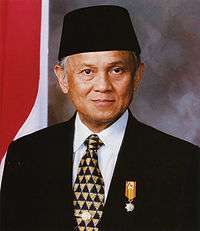
In January 1998, after accepting nomination for a seventh term as President, Suharto announced the selection criteria for the nomination of a vice president. Suharto did not mention Habibie by name, but his suggestion that the next vice president should have a mastery of science and technology made it obvious he had Habibie in mind.[22]
In that year, in the midst of the Asian Financial Crisis, this suggestion was received badly, causing the rupiah to fall. Despite this, Habibie was elected as Vice President in March 1998.[23]
Presidency

On 21 May 1998, just two months into Habibie's vice presidency, Suharto announced his resignation. Habibie, as the Constitution says, succeeded him as president. The following day, Habibie announced the Development Reform Cabinet, which removed some of the most controversial ministers in Suharto's last cabinet while maintaining others - with no major figures from the opposition. Within days of his appointment, he asked his relatives to resign from government positions, promised an early election, repealed some legislation, and ordered the release of political prisoners.[24]
East Timor
Habibie was opposed to East Timorese Independence but did offer East Timor special autonomy.[25]
Timorese independence forces led by the National Council of Timorese Resistance had been calling for a referendum in the territory for some time. Its chief diplomat, Jose Ramos Horta, proposed a transitional period of autonomy leading up to a referendum.[26] In late 1998, John Howard, the Prime Minister of Australia, sent a letter to Habibie suggesting that Indonesia defuse the East Timorese issue by providing autonomy to be followed by the promise of a referendum in the long run, following the method used by France to settle New Caledonian demands for independence. Wishing to avoid the impression that Indonesia ruled East Timor as a colony, Habibie surprised some by announcing that a referendum, offering a choice between special autonomy and independence, would be held immediately in East Timor. Leaders of the Indonesian armed forces (ABRI) were not consulted on this decision.[27]
On 30 August 1999, the referendum was held and the East Timorese people overwhelmingly chose Independence. Subsequently, pro-Indonesia militias killed and displaced large numbers of people during the 1999 East Timorese crisis.[28] On 10 September, General Wiranto allegedly threatened to stage a military coup if Habibie allowed in peacekeeping forces, causing Habibie to back down.[29] On 12 September, however, Habibie accepted a UN-mandated peacekeeping force to halt violence.[27] A UN administration followed and East Timor became independent in 2002.
Suharto's corruption charge
The MPR Special Session in November 1998 decried the presence of corruption in Indonesia, focusing particularly on Suharto.[30] In response to this, Habibie then appointed Andi Muhammad Ghalib as Attorney General.[23] A tape of a telephone conversation between Habibie and Ghalib was made public. It raised concerns about the veracity of the investigation by suggesting that the interrogation of Suharto was intended only for public appearances.[31]
Under Habibie, the Indonesian government also began investigating and prosecuting Suharto's youngest son, Hutomo Mandala Putra (commonly known as Tommy Suharto). Ghalib charged Tommy in December 1998 in conjunction with the Goro scandal, where the government, under pressure from Tommy, allegedly gave him a desirable parcel and below-market loan for the construction of a Goro supermarket. However, Tommy was found innocent in the case after several key witnesses, including Habibie aide Rahardi Ramelan, changed their testimony and declared that the deal did not cause losses to the state.[32]
Habibie's government stabilized the economy in the face of the Asian financial crisis and the chaos of the last few months of Suharto's presidency.[33] Habibie's government began to make conciliatory gestures towards Chinese-Indonesians who, because of their elite status, were targeted in the riots of 1998. In September 1998, Habibie issued a 'Presidential Instruction' forbidding use of the terms pribumi and non-pribumi to differentiate indigenous and non-indigenous Indonesians.[34]
In May 1999, Habibie directed that an ID card was sufficient proof of Indonesian citizenship, revoking the previous requirement for a 'Letter of Evidence of Republic of Indonesia Citizenship' (SBKRI). Additionally, he lifted restrictions on the teaching of Mandarin Chinese.[35]
Political reform
Under Habibie, Indonesia made significant changes to its political system that expanded competition and freedom of speech. Shortly after taking office, in June 1998, Habibie's government lifted the Suharto-era restriction on political parties and ended censorship by dissolving the Information Ministry. He also quickly committed to holding democratic elections, albeit on an initially vague timetable. In December, he proposed political reform laws that were passed by the legislature and MPR. These laws set elections for December 1999, reduced the number of seats in parliament held by the military, and barred political activity by civil servants.[36]
However, political opponents criticized Habibie for allowing the military to retain some seats in parliament, and taking little action on other military and judicial reforms.[37]
Habibie's government also passed laws which granted significant autonomy to regional governments, namely at the regency and city level. The laws resulted in indirect elections for mayors and regents, and allowed local legislatures to hold said executives accountable, though it was not implemented until after his presidency.[38]
End of presidency
Although he had been viewed as leading a transitional government, Habibie seemed determined to continue as president. He was initially unclear about whether he would seek a full term as president when he announced parliamentary elections in June 1998.[36] Habibie faced opposition from many within the government party, Golkar; in July 1998, he struggled to win control of Golkar by appointing Akbar Tandjung as chair of the party, but was ultimately able to defeat a rival camp including former Vice President Try Sutrisno, Defence Minister Edi Sudrajat, Siswono Yudhohusodo, and Sarwono Kusumaatmadja.[39] Habibie began to lose support from Akbar Tandjung and a faction in Golkar, composed of both reformers and hardliners, that wanted to oust him. In March 1999, Golkar put forth five presidential nominees: Habibie, Tandjung, Wiranto, Hamengkubuwono X, and Ginandjar Kartasasmita.[40] In May 1999, after extensive lobbying, Golkar announced that Habibie would be their presidential candidate, but a large faction in the party remained loyal to Tandjung and opposed to Habibie.[41] His political credibility was tarnished by the exposure of the 1999 Bank Bali scandal, in which banking funds were funneled to members of Habibie's re-election team.[42]
At the 1999 MPR General Session in October, Habibie delivered an accountability speech. MPR members then began voting to decide if they would accept or reject his speech. Habibie attempted to win the support of the military by offering the vice-presidency to General Wiranto, but his offer was declined.[43] Tandjung's Golkar faction broke ranks and voted against him, and his accountability speech was rejected by 355 votes to 322, and Habibie withdrew his nomination as President.[44] He was succeeded by Abdurrahman Wahid.
Post-presidency, final years and death
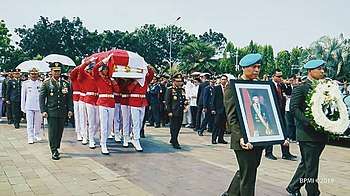
After relinquishing the presidency, Habibie spent more time in Germany than in Indonesia, though he was active during Susilo Bambang Yudhoyono's presidency as a presidential adviser. During this time, he established the Habibie Centre, an independent think tank.[45]
In September 2006, he released a book called Detik-Detik Yang Menentukan: Jalan Panjang Indonesia Menuju Demokrasi (Decisive Moments: Indonesia's Long Road Towards Democracy). The book recalled the events of May 1998 which led to his rise to the Presidency. In the book, he controversially accused Lieutenant General Prabowo Subianto, Suharto's son-in-law (at that time) and the Kostrad Commander, of planning a coup d'état against him in May 1998.[46]
In early September 2019, he was admitted to Gatot Soebroto Army Hospital, where he was undergoing treatments for heart problems,[47][48] namely cardiomyopathy,[49] and died on 11 September 2019.[50][51][52][53][54] He became the first Indonesian President to be buried at the Kalibata Heroes Cemetery, next to his wife's grave.[55]
In response to his death, the Government of Indonesia announced a three-day national mourning period starting on 12 September, and announced that the Indonesian flag is to be flown at half-staff during the period.[56]
On 12 September 2019, video was released showing East Timor's former President, Xanana Gusmão, visiting Habibie in hospital on 22 July 2019. Gusmao is shown talking briefly to Habibie while crying, then kissing Habibie on the forehead and lowering his face to Habibie’s chest, with the other holding his head. A wreath in Gusmao’s name was at the funeral, with a sign reading: "Profound Condolences – With heartfelt sympathy for the loss of Big Brother President B.J. Habibie – Timorese people will remember you forever – Rest in Peace - Xanana Gusmão".[57]
Family

Habibie was married to Hasri Ainun Besari, a medical doctor, from 12 May 1962 until her death on 22 May 2010. Their wedding was held in Javanese and Gorontalese culture.[58] The couple had two sons, Ilham Akbar Habibie and Thareq Kemal Habibie.
B. J. Habibie's brother, Junus Effendi Habibie, was Indonesian ambassador to the United Kingdom and the Netherlands.[59][60] After his wife's death, Habibie published a book titled Habibie & Ainun which recounts his relationship with Hasri Ainun from their courtship until her death. The book was adapted into a film of the same name which was released on 20 December 2012.[61]
Honours, decorations, and distinctions
Habibie received several honorary degrees for his contributions in the fields of technology and science, e.g. he was awarded an Honorary DSc degree from the Cranfield Institute of Technology (United Kingdom) and Dr.h.c. degrees from Chungbuk National University and Hankuk University of Foreign Studies (South Korea) for his services to aircraft technology.[62] In 2010, Habibie was honored with an Honorary PhD degree in Technology by the University of Indonesia for his contribution to science in practice as a technocrat.[63]
Habibie was appointed a Fellow of the Royal Academy of Engineering (FREng) in 1990.[64] In 1993, he was awarded an Honorary Fellow of the Royal Aeronautical Society (HonFRAeS).[65] He was also named an honorary member of several professional bodies, including:
- Malaysian Engineers Association (IEM)
- Japanese Academy of Engineering
- Fellowship of Engineering of the United Kingdom, London
- National Academy of Engineering, USA
- Academie Nationale de l'Air et de l'Espace, France
- Royal Aeronautical Society, UK
- Royal Swedish Academy of Engineering Science
- Deutsche Gesellschaft für Luft- und Raumfahrt (German Institute for Aviation & Space), Germany
- American Institute of Aeronautics and Astronautics, USA
Timor-Leste named a bridge and park after Habibie shortly before his death.[52]
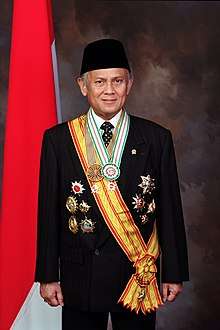
As vice president, and later president of Indonesia, he was automatically bestowed the highest class of all civilian and military Star Decorations, namely:[66]





.png)



_-_ribbon_bar.png)

In popular culture
Movies
Habibie has been portrayed in several biopic movies based on both his political and personal life. In the first installment of Habibie & Ainun (2012) and its prequels, Rudy Habibie (2016) and Habibie & Ainun 3 (2019), Habibie is portrayed by Reza Rahadian, while Bima Azriel and Bastian Bintang Simbolon portrayed Habibie[67] during his childhood, and teenage years in Rudy Habibie respectively.
In the movie Di Balik 98, Habibie was portrayed by Agus Kuncoro.
Notes
- Salam, S., 1986. BJ Habibie, Mutiara dari Timur. Intermasa.
- Elson, R.E., 2009. The idea of Indonesia. Penerbit Serambi.
- Habibie, B.J., 2010. Habibie & Ainun. THC Mandiri.
- Hendrowinoto, N.K.S. ed., 2004. Ibu Indonesia dalam kenangan. Bank Naskah Gramedia bekerja sama dengan Yayasan Biografi Indonesia.
- Noer, G.S., 2015. Rudy: Kisah Masa Muda Sang Visioner. Bentang Pustaka.
- Makka, A. Makmur (1999). BJH: Bacharuddin Jusuf Habibie, kisah hidup dan kariernya (in Indonesian). Pustaka CIDESINDO. p. 13. ISBN 9789799064080.
- Muhammad El Brahimy (2012). Biografi Presiden dan Wakil Presiden RI (in Indonesian). PT Balai Pustaka (Persero). p. 5. ISBN 9789796904150.
- "Habibie: nauwe band met Delft". Habibie: nauwe band met Delft - TU Delta.
- Habibie 2010, p. 4
- Habibie 2010, p. 1
- Makka 2008, pp. 72–75.
- Makka 2008, pp. 79–80.
- Habibie 2010, p. 28
- Habibie 2010, p. 41
- O'Rourke 2002, p. 140
- O'Rourke 2002, p. 142
- "Our History". Indonesian Aerospace. Archived from the original on 18 October 2006. Retrieved 30 October 2006.
- The Economist. 17 April 1993.
- Amir, Sulfikar (2012). The Technological State in Indonesia: The Co-constitution of High Technology and Authoritarian Politics. Routledge. pp. 69–70. ISBN 9780415670692.
- Makka 2008, p. 190.
- Hefner, Robert W. (2000). Civil Islam: Muslims and Democratization in Indonesia. Princeton NJ: Princeton University Press. pp. 128–138. ISBN 0691050465.
- "Delapan Calon Wapres Itu: Di Antara Pujian dan Kritik". Tempo. 7 February 1998. Archived from the original on 27 September 2007. Retrieved 30 October 2006.
- Chandra, Alexander C. (2008). Indonesia and the ASEAN Free Trade Agreement: Nationalists and Regional Integration Strategy. Lexington Books. p. 103. ISBN 9780739116203.
- "Indonesia's new president on a tide of troubles". The Economist. 28 May 1998. Retrieved 11 September 2019.
- Miller, M. (2004). 'From reform to repression: the post-New Order's shifting security policies in Aceh', Review of Indonesian and Malaysian Affairs, 38(4), 129–162.
- Ramos Horta, Jose (1996). Towards a Peaceful Solution in East Timor. Sydney: East Timor Relief Association. ISBN 0958686009.
- "Howard's letter to Habibie". School of Humanities and Social Sciences - UNSW Canberra. Archived from the original on 28 March 2015.
- Robinson, Geoffrey (2010). If You Leave Us Here, We Will Die: How Genocide was Stopped in East Timor. Princeton NJ: Princeton University Press. ISBN 9780691135366.
- O'Rourke 2002, p. 272
- Ziegenhain, Patrick (2008). The Indonesian Parliament and Democratization. Institute of Southeast Asian Studies. p. 101. ISBN 9789812304858.
- Elson, Robert (2001). Suharto: A Political Biography. UK: The Press Syndicate of the University of Cambridge. p. 295. ISBN 0-521-77326-1.
- O'Rourke 2002, p. 232
- Suprapto, Eddy; et al. (18 October 1999). "Bung Rudy, In Rapormu! Mengintip Pertanggungjawaban BJ Habibie". Kontanonline.com as found on hamline.edu. Archived from the original on 15 September 2006. Retrieved 28 October 2006.
- Purdey, Jemma (2006). Anti-Chinese Violence in Indonesia, 1996–1999. Singapore: Singapore University Press. p. 179. ISBN 9971-69-332-1.
- Suryadinata, Leo (2008). Ethnic Chinese in Contemporary Indonesia. Institute of Southeast Asian Studies. p. 143. ISBN 9789812308351.
- O'Rourke 2002, p. 145
- O'Rourke 2002
- Bohlken 2016, p. 220.
- O'Rourke 2002, p. 156
- O'Rourke 2002, p. 228
- O'Rourke 2002, p. 236
- Samuel S. Kim (25 October 2000). East Asia and Globalization. Rowman & Littlefield Publishers. pp. 224–. ISBN 978-0-7425-7760-2.
- O'Rourke 2002, p. 312
- Spencer, Geoff (20 October 1999). "Indonesia's Habibie Withdraws". AP News. Retrieved 11 September 2019.
- "[OBITUARI] BJ Habibie, "Bapak Pesawat" yang Tak Pernah Tertarik Jadi Presiden". KOMPAS (in Indonesian). 11 September 2019. Retrieved 11 September 2019.
- Dariyanto, Erwin (31 July 2017). "Prabowo Dipecat atau Diberhentikan? Ini Cerita BJ Habibie". detikNews (in Indonesian). Retrieved 11 September 2019.
- Ambaranie Movanita (11 September 2019). "BJ Habibie Meninggal Dunia di RSPAD" (in Indonesian). Retrieved 11 September 2019.
- "BJ Habibie Dirawat di Ruang CICU RSPAD Gatot Soebroto". 8 September 2019. Retrieved 11 September 2019.
- Siyahailatua, Sarah Ervina Dara (12 September 2019). "BJ Habibie Punya Riwayat Kesehatan Lemah Jantung, Apa Itu?". Tempo (in Indonesian). Retrieved 12 September 2019.
- Alaidrus, Fadiyah (11 September 2019). "B.J. Habibie Meninggal Dunia, 11 September Petang Ini" (in Indonesian). Retrieved 11 September 2019.
- Indra Komara (11 September 2019). "BJ Habibie Meninggal Dunia". Detik.com (in Indonesian). Retrieved 11 September 2019.
- "Former Indonesian President Habibie Dies at Age 83". The New York Times. The Associated Press. 11 September 2019. ISSN 0362-4331. Retrieved 11 September 2019.
- hermesauto (11 September 2019). "Former Indonesian president Habibie, who described Singapore as a 'little red dot', dies aged 83". The Straits Times. Retrieved 11 September 2019.
- Reuters (11 September 2019). "Indonesia's Habibie, president during transition to democracy, dies". New Straits Times. Media Prima Group. Retrieved 11 September 2019.
- Andhika Prasetia (11 September 2019). "BJ Habibie Akan Dimakamkan di Samping Makam Ainun". Detik.com (in Indonesian).
- "Government declares three-day mourning for Habibie". Antara News. 11 September 2019. Retrieved 11 September 2019.
- Video of Xanana Gusmao embracing BJ Habibie in hospital bed shared after former Indonesian leader's death, Anne Barker, ABC News Online, 13 September 2019
- Habibie, B.J., 2010. ''Habibie & Ainun''. THC Mandiri.
- "Former First Lady Hasri Ainun Habibie Dies At 72". Jakarta Globe. 23 May 2010. Archived from the original on 24 May 2010. Retrieved 23 May 2010.
- "Brother of Former President BJ Habibie, Fanny Habibie, Dies at 74". Antara. Archived from the original on 14 April 2012. Retrieved 18 May 2012.
- "Former President Habibie's Love Story to Hit the Big Screen - The Jakarta Globe". Archived from the original on 18 December 2012. Retrieved 17 December 2012.
- Rektor UI Terima Penghargaan dari Chonbuk National University - website of newspaper Pikiran Rakyat
- Post, The Jakarta. "Habibie gets his 4th honorary doctorate, this time from UI".
- "List of Fellows - Royal Academy of Engineering".
- WOW_Medals_and_Awards - website of the Royal Aeronautical Society
- Johannes Nainggolan (12 September 2019). "11 Tanda Kehormatan dan Bintang Jasa Almarhum BJ Habibie Dibacakan". Indozone.id (in Indonesian).
- brilio.net (30 June 2016). "Kenalan yuk sama Bima, pemeran Habibie kecil di film Rudy Habibie".
Bibliography
- Bohlken, Anjali Thomas (2016). Democratization from Above: The Logic of Local Democracy in the Developing World. Cambridge University Press. ISBN 9781107128873.CS1 maint: ref=harv (link)
- Habibie, Bacharuddin Jusuf (2010). Habibie & Ainun (in Indonesian). THC Mandiri. ISBN 9789791255134.CS1 maint: ref=harv (link)
- Makka, A. Makmur (2008). The true life of Habibie: cerita di balik kesuksesan (in Indonesian). PT Mizan Publika. ISBN 9789793371832.CS1 maint: ref=harv (link)
- O'Rourke, Kevin (2002). Reformasi: The Struggle for Power in Post-Soeharto Indonesia. Allen & Unwin. ISBN 9781865087542.CS1 maint: ref=harv (link)
External links
| Wikimedia Commons has media related to Bacharuddin Jusuf Habibie. |
- Habibie's homepage while he served as the State Minister of Research and Technology at the Wayback Machine (archive index)
- The Habibie Center, an NGO founded by Habibie
| Political offices | ||
|---|---|---|
| Preceded by Suharto |
President of Indonesia 1998–1999 |
Succeeded by Abdurrahman Wahid |
| Preceded by Try Sutrisno |
Vice President of Indonesia 1998 |
Succeeded by Megawati Sukarnoputri |
| Preceded by Soemitro Djojohadikoesoemo |
State Minister for Research and Technology of Indonesia 1978–1998 |
Succeeded by Rahardi Ramelan |
| Government offices | ||
| New title | Head of Agency for the Assessment and Application of Technology 1974–1998 |
Succeeded by Rahardi Ramelan |

